The Automotive Weatherstrips Market is estimated to be valued at USD 3.3 billion in 2025 and is projected to reach USD 5.2 billion by 2035, registering a compound annual growth rate (CAGR) of 4.7% over the forecast period.
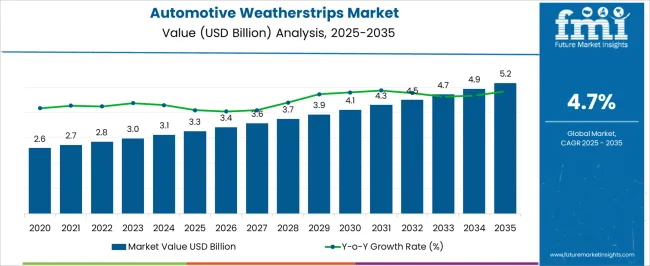
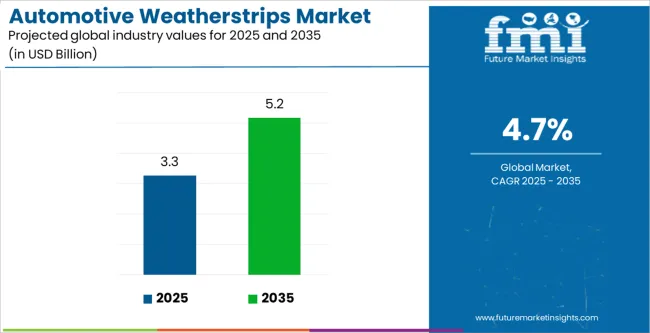
| Metric | Value |
|---|---|
| Automotive Weatherstrips Market Estimated Value in (2025 E) | USD 3.3 billion |
| Automotive Weatherstrips Market Forecast Value in (2035 F) | USD 5.2 billion |
| Forecast CAGR (2025 to 2035) | 4.7% |
The Automotive Weatherstrips market is experiencing steady expansion as vehicle manufacturers and suppliers increasingly emphasize comfort, safety, and durability in automotive design. The current landscape reflects rising adoption of advanced sealing solutions that prevent water leakage, reduce noise, and enhance thermal insulation, creating a more reliable and comfortable driving experience. Increasing consumer demand for energy efficiency, coupled with strict regulatory requirements around vehicle safety and emissions, is pushing OEMs to integrate high-performance weatherstrips.
The material shift toward durable and recyclable compounds is further shaping product innovation. With the growing vehicle production in emerging economies and rising focus on lightweight yet resilient sealing systems, demand for weatherstrips is expanding across passenger and commercial segments.
Additionally, the adoption of electric vehicles has highlighted the importance of superior sealing to ensure battery protection and cabin insulation As sustainability trends reshape the supply chain, advancements in elastomer technologies and increased localization of production are expected to provide future growth opportunities for manufacturers in this market.
The automotive weatherstrips market is segmented by material type, end use, vehicle type, sales channel, and geographic regions. By material type, automotive weatherstrips market is divided into EPDM (Ethylene Propylene Diene Terpolymer Membrane) Rubber, Polyvinyl Chloride (PVC) Rubber, and Thermoplastic Elastomer/Rubber (TPE). In terms of end use, automotive weatherstrips market is classified into Doorframe, Windows, Roof Rail, Windshield, and Trunk (Front & Rear). Based on vehicle type, automotive weatherstrips market is segmented into Passenger Cars, Compact, Mid-Size, SUV, Luxury, Light Commercial Vehicles (LCVs), and Heavy Commercial Vehicles (HCVs). By sales channel, automotive weatherstrips market is segmented into Original Equipment Manufacturers (OEM) and Aftermarket. Regionally, the automotive weatherstrips industry is classified into North America, Latin America, Western Europe, Eastern Europe, Balkan & Baltic Countries, Russia & Belarus, Central Asia, East Asia, South Asia & Pacific, and the Middle East & Africa.
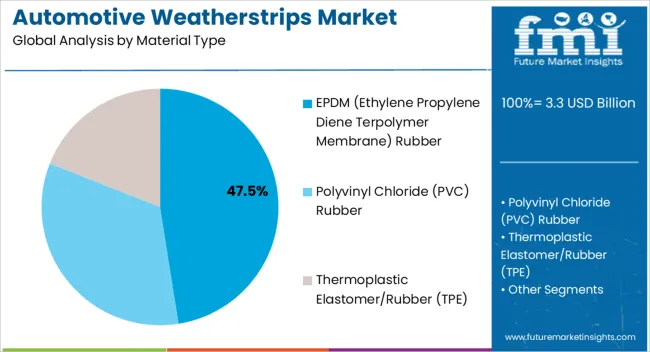
The EPDM Rubber material type is projected to account for 47.50% of the overall Automotive Weatherstrips market revenue in 2025, making it the leading segment. Its dominance is being attributed to excellent resistance against heat, ozone, and weathering, which ensures long-term durability and performance under varying environmental conditions. EPDM rubber offers superior flexibility and sealing properties, which has made it the preferred choice among automotive OEMs for applications across windows, doors, and windshields.
The material’s cost efficiency and ability to maintain elasticity across wide temperature ranges have reinforced its widespread adoption. Additionally, the increasing push toward reducing cabin noise and vibration has strengthened demand for EPDM-based sealing systems, as they provide reliable sound insulation.
Another factor contributing to its strong market position is its recyclability, aligning with the automotive industry’s focus on sustainable material use As vehicle lifespans extend and the demand for high-performance sealing materials rises, EPDM rubber is expected to remain the most widely utilized compound in the weatherstrips market.
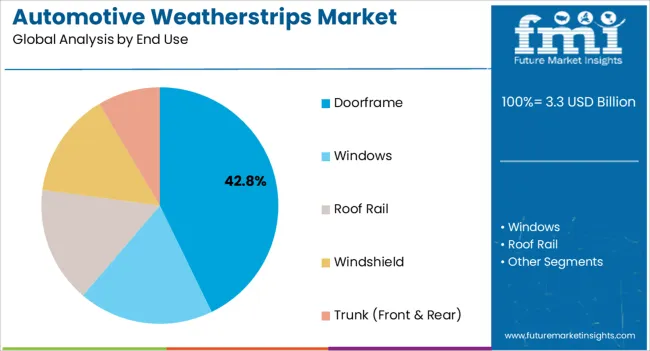
The Doorframe end use segment is anticipated to account for 42.80% of the Automotive Weatherstrips market revenue in 2025, emerging as the dominant application area. This leadership is being driven by the critical role of doorframe weatherstrips in preventing water, dust, and noise intrusion into the vehicle cabin. Superior sealing in doorframes ensures enhanced passenger comfort and protects the vehicle’s structural integrity, especially in harsh weather conditions.
As customer expectations for noise reduction and improved insulation increase, manufacturers are investing heavily in advanced sealing technologies tailored to doorframe integration. The growth of this segment has also been supported by rising vehicle production volumes globally, particularly in passenger vehicles that require precise sealing systems to meet safety and quality standards.
The durability and ease of installation of doorframe weatherstrips have further reinforced their demand With technological advancements enabling improved materials that reduce friction and improve longevity, doorframe weatherstrips are expected to continue leading market adoption as automakers seek reliable sealing solutions.
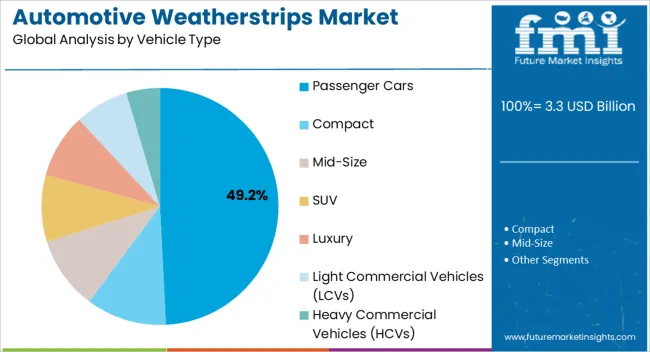
The Passenger Cars vehicle type segment is forecasted to hold 49.20% of the Automotive Weatherstrips market revenue in 2025, establishing itself as the leading end-use category. This dominance has been shaped by the consistently high production volumes of passenger vehicles worldwide, which generate significant demand for advanced sealing solutions. Passenger cars require multiple weatherstrip applications across windows, doors, trunks, and windshields, thereby expanding the consumption of these products per unit vehicle.
Increasing consumer focus on driving comfort, cabin insulation, and noise reduction has further accelerated the use of premium weatherstrips in passenger cars. The rising adoption of electric vehicles within this category has also boosted demand, as EVs require enhanced sealing to protect battery compartments and ensure optimal cabin acoustics.
With automakers aiming to deliver improved ride quality and meet stringent performance benchmarks, passenger cars are becoming the largest contributors to weatherstrip usage This trend is expected to continue as urban mobility, electrification, and premiumization drive innovation and integration of high-quality weatherstrips in this segment.
Automotive weatherstrips are rubber seals used to seal the edges of the windows, doors, windshield, and trunks of an automobile. Automotive weatherstrips prevent elements such as dust, rain, and snow to enter the vehicle. Moreover, automotive weatherstrips manage air flow between the hood and the engine compartment and prevent the interior components and accessories of the vehicles from damage.
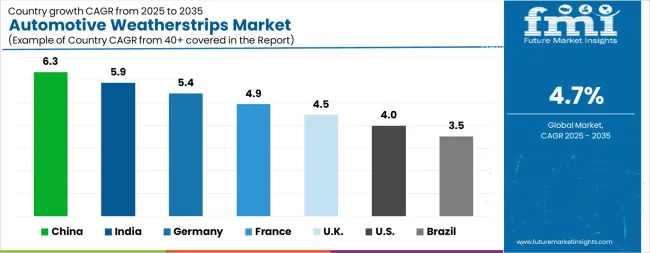
| Country | CAGR |
|---|---|
| China | 6.3% |
| India | 5.9% |
| Germany | 5.4% |
| France | 4.9% |
| UK | 4.5% |
| USA | 4.0% |
| Brazil | 3.5% |
The Automotive Weatherstrips Market is expected to register a CAGR of 4.7% during the forecast period, exhibiting varied country level momentum. China leads with the highest CAGR of 6.3%, followed by India at 5.9%. Developed markets such as Germany, France, and the UK continue to expand steadily, while the USA is likely to grow at consistent rates. Brazil posts the lowest CAGR at 3.5%, yet still underscores a broadly positive trajectory for the global Automotive Weatherstrips Market. In 2024, Germany held a dominant revenue in the Western Europe market and is expected to grow with a CAGR of 5.4%. The USA Automotive Weatherstrips Market is estimated to be valued at USD 1.1 billion in 2025 and is anticipated to reach a valuation of USD 1.7 billion by 2035. Sales are projected to rise at a CAGR of 4.0% over the forecast period between 2025 and 2035. While Japan and South Korea markets are estimated to be valued at USD 176.1 million and USD 84.0 million respectively in 2025.
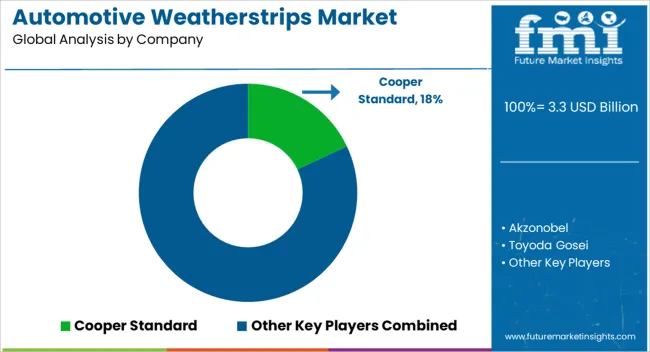
| Item | Value |
|---|---|
| Quantitative Units | USD 3.3 Billion |
| Material Type | EPDM (Ethylene Propylene Diene Terpolymer Membrane) Rubber, Polyvinyl Chloride (PVC) Rubber, and Thermoplastic Elastomer/Rubber (TPE) |
| End Use | Doorframe, Windows, Roof Rail, Windshield, and Trunk (Front & Rear) |
| Vehicle Type | Passenger Cars, Compact, Mid-Size, SUV, Luxury, Light Commercial Vehicles (LCVs), and Heavy Commercial Vehicles (HCVs) |
| Sales Channel | Original Equipment Manufacturers (OEM) and Aftermarket |
| Regions Covered | North America, Europe, Asia-Pacific, Latin America, Middle East & Africa |
| Country Covered | United States, Canada, Germany, France, United Kingdom, China, Japan, India, Brazil, South Africa |
| Key Companies Profiled | Cooper Standard, Akzonobel, Toyoda Gosei, Hutchinson, Henniges, Nishikawa, SaarGummi, Kinugawa, Hwaseung, Tokai Kogyo, and Guihang |
The global automotive weatherstrips market is estimated to be valued at USD 3.3 billion in 2025.
The market size for the automotive weatherstrips market is projected to reach USD 5.2 billion by 2035.
The automotive weatherstrips market is expected to grow at a 4.7% CAGR between 2025 and 2035.
The key product types in automotive weatherstrips market are epdm (ethylene propylene diene terpolymer membrane) rubber, polyvinyl chloride (pvc) rubber and thermoplastic elastomer/rubber (tpe).
In terms of end use, doorframe segment to command 42.8% share in the automotive weatherstrips market in 2025.
Explore Similar Insights

Thank you!
You will receive an email from our Business Development Manager. Please be sure to check your SPAM/JUNK folder too.
Chat With
MaRIA